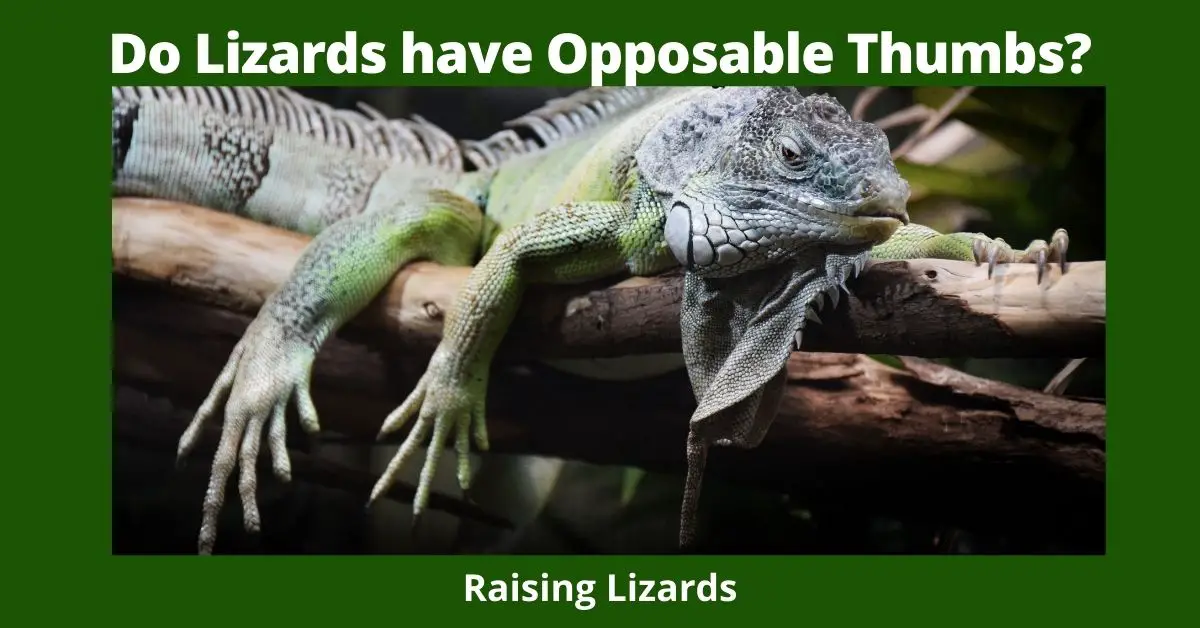Lizards do not have opposable thumbs. They have 5 toes that are very strong. Their first toe is opposable that helps them grab a branch.
Do Lizards have Opposable Thumbs?
Do lizards have opposable thumbs? This is a question that has long been debated by scientists. Some say that lizards do not have opposable thumbs because they cannot touch their thumb to their other fingers. Others argue that because lizards can grip things with their toes, they must have opposable thumbs. In this blog post, we will explore the evidence for and against lizards having opposable thumbs and let you decide for yourself!
What are Opposable thumbs?
Opposable thumbs are a characteristic of humans and certain other primates. They are fingers that can be opposed, or brought together, against the palm. This allows the hand to grip objects firmly.
The presence of opposable thumbs is one of the features that distinguishes human beings from other animals. They allow us to use tools, which has been key to our success as a species. Other primates also have opposable thumbs, but they are not as highly developed as ours. This may be why humans have been able to spread across the globe and dominate other animal species. Do Lizards have Opposable Thumbs?

Do Lizards Have Opposable Thumbs?
The answer to this question is a resounding no. Their first toe is opposable which helps them grip branches. Lizards do not have opposable thumbs, or hands for that matter.
If you have ever seen a lizard, then you know that they do not have hands or even claws. They have no opposable thumbs! Their feet are used for digging and other purposes such as collecting food morsels from cracks between rocks and branches.
Their hands don’t look like ours at all; instead of fingers, there are just two long toes with curved nails on them which help them climb trees or grab onto things when running away from predators. These lizards can walk right up against walls because their claws provide traction against gravity so well!
What types of Toes do Lizards Have?
Lizards have five toes on their front feet and four toes on their back feet. The toes are usually long and slender, with sharp claws that help them climb and catch prey. Some lizards also have a toe or two that is webbed, which helps them swim better.
What are a lizard’s toes called?
The toes of a lizard are called phalanges. They assist the lizard in many ways including walking, running and catching prey, or defending itself. Lizards have sharp claws on their feet which are used for digging into soft soil or sand as well as climbing up tree trunks and branches.
Why do lizards have claws?
Lizards use their claws to dig burrows, climb trees and catch prey. Some species also use them for self-defense by kicking out at predators when threatened with danger from above (such as hawks).
In addition to being useful appendages that help lizards stay balanced while moving around quickly through brushy areas without tripping over obstacles such as twigs or fallen leaves lying on the ground below them
Lizards use their toes for many different activities, including walking, running, climbing, swimming, and catching prey. Their sharp claws help them grip surfaces and dig burrows. The webbed toes help them move through the water more easily.
How Strong are Lizards toes, Phalanges?
Lizards are reptiles that belong to the Squamata order. There are over 6000 species of lizards in the world, and they inhabit every continent on Earth except Antarctica.
They come in a wide variety of sizes and colors. The smallest lizard is just under an inch long, while the largest can grow up to 11 feet long!
The largest lizards include Komodo dragons (Varanus komodoensis), crocodile monitors (Varanus salvadorii), green iguanas (Iguana iguana), and Gila monsters (Heloderma suspectum). The smallest lizard is Sphaerodactylus ariasae from Cuba which measures only 16 mm or 0.63 inches in snout-vent length.
Lizards have a long, snake-like body and a forked tongue that they use to smell. They also have external ears and movable eyelids. Lizards can lose their tails when threatened by predators; the tail will wriggle around after it is detached from the lizard’s body, distracting the predator while the lizard escapes.
The feet of lizards are interesting because they have four toes on each front foot (digit) and five toes on each back foot. The first toe on both the front and back feet is opposable to the other toes, meaning it can be used as a thumb to grip objects. This makes lizards very good climbers!
Each toe has two phalanges or bone sections, a proximal phalanx and distal phalanx. The most distal bones on each toe are called claws which are curved to help with climbing.

Do any Reptiles have opposable thumbs?
No they do not. All Reptiles lack opposable thumbs, which is necessary for prehension (grasping and manipulating objects). This adaptation limits their manipulative abilities and dexterity.
Some reptiles, like snakes, can coil around an object to hold it tightly, but they cannot pick up or carry anything in their hands. Turtles are the best at manipulating objects with their beaks and claws, but they still cannot use their hands to grip or hold things.
The Animals that have Opposable Thumbs are:
- Humans – Humans have opposable thumbs that they use to grip objects and make things.
- Gorillas – Gorillas can hold heavy objects with opposable thumbs. Their thumbs are also used for climbing trees.
- Monkeys – Monkeys have very strong opposable thumbs which allow them to cling onto branches of trees or other surfaces as well as take
- Apes – Apes have opposable thumbs like humans.
- Sloths – Sloths are arboreal mammals noted for slowness of movement and for spending most of their lives hanging upside down in the trees of the tropical rainforests of South America and Central America. Their arms may be used to hang on branches or wiggle through narrow spaces,
- Old World Monkeys – These monkeys have opposable thumbs which give them an advantage in grasping tree branches.
- New World Monkeys – These monkeys have opposable thumbs, but they are not as developed as the Old World Monkeys.
- Baboons – Baboons are terrestrial (ground-living) and mostly herbivorous (plant-eating) primates that live in Africa and Arabia. They are the largest monkeys in the world.
- Rhesus Macaques – Rhesus macaques have opposable thumbs which they use to hold food.
- Spider Monkeys – These monkeys live in trees and their arms are very long, allowing them to move through the trees quickly. They also have opposable thumbs.
- Lemurs – Lemurs are primates that live in Madagascar. They have opposable thumbs which allow them to hold onto branches with their hands while climbing trees or walking across narrow areas such as tight ropes.
- Orangutans – Orangutans can use their opposable thumbs to grasp objects and climb trees easily. Their large size also gives them an advantage
- Koalas – Koalas are herbivorous (plant-eating) marsupials that live in eucalyptus trees. They have strong, opposable thumbs for grasping branches and climbing trees.
- Giant Pandas – These mammals can use their opposable thumbs to climb trees or hold onto bamboo shoots.
- Kangaroos – Kangaroos have powerful hind legs which they use to jump long distances. They also have strong arms and opposable thumbs that allow them to climb trees or grasp objects with their fore-limbs while running on land.
- Possums – Possums are nocturnal (night-active) marsupials that live in forests, shrubs, and trees. They have opposable thumbs which they use to climb and hold on to things.
Final Thoughts – Do Lizards have Opposable Thumbs?
Their hands don’t look like ours at all; instead of fingers, there are just two long toes with curved nails on them which help them climb trees or grab onto things when running away from predators. These lizards can walk right up against walls because their claws provide traction against gravity so well!


